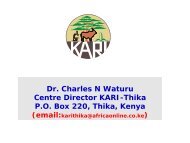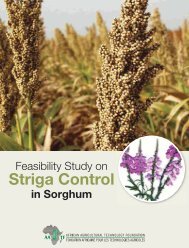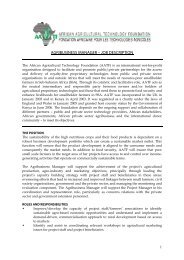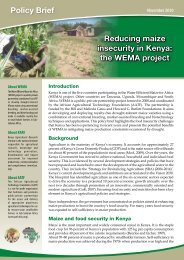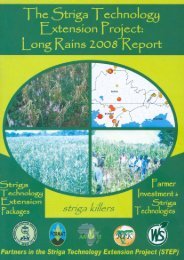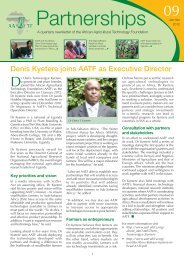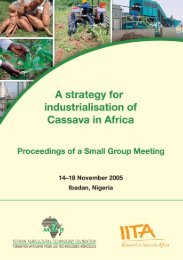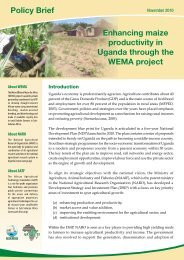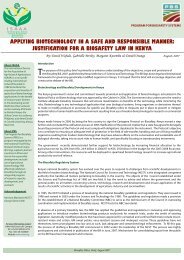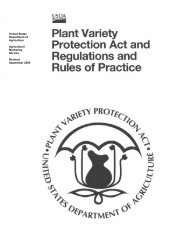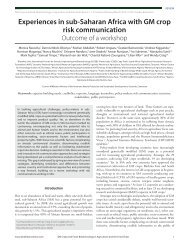Baseline Study of Striga Control using IR Maize in Western Kenya
Baseline Study of Striga Control using IR Maize in Western Kenya
Baseline Study of Striga Control using IR Maize in Western Kenya
Create successful ePaper yourself
Turn your PDF publications into a flip-book with our unique Google optimized e-Paper software.
Chapter 5Livelihood Strategies and Outcomes5.1 Livelihood strategies: Rural non-farm activitiesFarmers diversify their livelihoods by engag<strong>in</strong>g <strong>in</strong> non-farm activities. This appears to be one<strong>of</strong> the most common strategies to hedge risk and reduce the negative impacts <strong>of</strong> shocks,trends and seasonality <strong>in</strong> agricultural production. Respondents <strong>in</strong> western <strong>Kenya</strong> were<strong>in</strong>volved <strong>in</strong> about 15 non-farm <strong>in</strong>come activities for both male and female headed households(Table 5.1). A high proportion <strong>of</strong> households were found engaged <strong>in</strong> petty trad<strong>in</strong>g, followedby agricultural wage employment, and non-agricultural wage employment. Other non-farm<strong>in</strong>come generat<strong>in</strong>g activities that were <strong>of</strong> importance are sell<strong>in</strong>g fuel wood and charcoal,handicraft, food for work, sell<strong>in</strong>g prepared food/dr<strong>in</strong>ks and pr<strong>of</strong>essional work. All age groupswere <strong>in</strong>volved <strong>in</strong> non-farm activities: adult males, adult females and youths. The number <strong>of</strong>households <strong>in</strong>volved <strong>in</strong> these activities was higher <strong>in</strong> Nyanza prov<strong>in</strong>ce compared to <strong>Western</strong>prov<strong>in</strong>ce.Table 5.1. Involvement <strong>of</strong> household members <strong>in</strong> non-farm <strong>in</strong>come sources (% <strong>of</strong>respondents)Male Headed HouseholdsFemale Headed HouseholdsAll(594)Nyanza(289)<strong>Western</strong>(305)All(208)Nyanza(113)<strong>Western</strong>(95)Honey production 1.0 1.7 0.3 0 0 0Agricultural wage employment 26.2 32.9 19.7 32.7 38.9 25.3Non-agricultural wage employment 27.4 28.7 26.2 18.8 21.2 15.8Food for work 10.4 13.5 7.5 17.8 17.7 17.9Petty trad<strong>in</strong>g 39.8 49.1 31.1 38.5 44.2 31.6Handicraft 10.4 18.7 2.6 11.5 21.2 0Transport service 5.0 4.2 5.9 1.0 0 2.1Gra<strong>in</strong> mills 1.2 0.3 2.0 1.0 0.9 1.1Fish<strong>in</strong>g 1.0 1.7 0.3 0 0 0Hunt<strong>in</strong>g and gather<strong>in</strong>g <strong>of</strong> wild food 1.3 1.7 1.0 1.0 0.9 1.1Sell<strong>in</strong>g fuel wood and charcoal 14.1 20.8 7.9 17.8 26.5 7.4Sell<strong>in</strong>g prepared food/dr<strong>in</strong>ks 7.9 13.1 3.0 10.1 16.8 2.1Pr<strong>of</strong>essional work 18.5 17.0 20.0 5.3 5.3 5.3Traditional medic<strong>in</strong>e 1.7 1.7 1.6 2.4 4.4 0Rent <strong>in</strong>come 2.9 2.8 3.0 0.5 0 1.1Figures <strong>in</strong> brackets <strong>in</strong>dicate number <strong>of</strong> respondents5.2 Household <strong>in</strong>come and povertyThe annual <strong>in</strong>come was calculated at an average <strong>of</strong> Ksh 52,678 per household, with the<strong>in</strong>come <strong>in</strong> <strong>Western</strong> a bit higher than that <strong>in</strong> Nyanza (Table 5.2). Off-farm <strong>in</strong>come was themajor source <strong>of</strong> <strong>in</strong>come, followed by farm <strong>in</strong>come. <strong>Maize</strong> <strong>in</strong>come represented about 27% <strong>of</strong>cash <strong>in</strong>come and about 48% <strong>of</strong> value <strong>of</strong> gross <strong>in</strong>come from crop production, confirm<strong>in</strong>g theimportance <strong>of</strong> maize not only as a food crop but also as a cash crop <strong>in</strong> western <strong>Kenya</strong>. Theproportion <strong>of</strong> maize <strong>in</strong>come <strong>in</strong> the farm <strong>in</strong>come was higher <strong>in</strong> Nyanza compared to <strong>Western</strong>.The per capita household <strong>in</strong>come corresponded to about US$ 0.34/day for Nyanza and US$0.36/day for <strong>Western</strong>, which is far below the World Bank poverty l<strong>in</strong>e <strong>of</strong> US$ 1/day/personused <strong>in</strong> <strong>in</strong>ternational poverty comparisons.32



